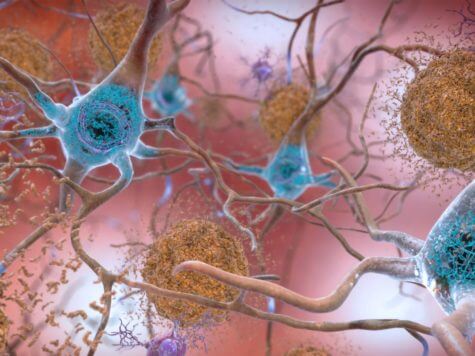UNIVERSITY PARK, Pa. — Scientists may be one step closer to an effective treatment for Alzheimer’s disease after pitting two promising drugs against each other in a groundbreaking clinical trial.
In a first-of-its-kind computer model, researchers from Penn State simulated the long-term effects of using the FDA-approved treatment aducanumab and the promising therapy donanemab, which is still in testing. Using this high-tech approach to clinical drug trials, the team was able to see how these drugs improve or fail to improve Alzheimer’s symptoms over a 10-year period.
“We’re calling this a virtual clinical trial, because we used real, de-identified patient data to simulate health outcomes,” says lead author Wenrui Hao, an associate professor of mathematics at Penn State, in a university release. “What we found aligns almost exactly with findings in prior clinical trials, but because we were using a virtual simulation, we had the added benefit of directly comparing the efficacy of different drugs over longer trial periods.”
Using clinical and biomarker data, the team created a computational causal model which compared the two Alzheimer’s therapies. Study authors note that both drugs are the first treatments designed to work directly on the suspected cause of the disease — not just alleviate the symptoms of Alzheimer’s.
Specifically, they looked at the medium-term (78 weeks) and long-term (10 years) effects of using low-dose (6 mg/kg) and high-dose (10 mg/kg) treatments of aducanumab, and a single 1,400 mg dose of donanemab. Importantly, these are the same exact doses doctors use to real-life, human Alzheimer’s trials.
Which medication does the best job against Alzheimer’s?
The virtual clinical trial helped researchers confirm what human clinical trials have been revealing over many years. Both drugs had a “large and sustained effect” on removing beta-amyloid plaques from the brain. This peptide is a hallmark of the disease, with studies finding that these plaques disrupt communication between neurons in the brain.
The virtual trial also found that both drugs had a small impact in terms of slowing down cognitive decline. However, donanemab was slightly better at this over a simulated 10-year period.
“With over 10 anti-amyloid therapies in development, an important question is which one is better,” says study collaborator and co-principal investigator Dr. Jeffrey Petrella, Professor of Radiology and Director of the Alzheimer Imaging Research Laboratory at Duke University. “It often takes tens of millions of dollars and many years to do a head-to-head comparison of drugs. Our study showed that the effect of these two anti-amyloid drugs on slowing cognitive decline is actually quite modest – and if given late in life, barely detectable.”
Petrella notes that the medical community still isn’t completely sure if removing amyloid plaques is an effective way of treating or preventing Alzheimer’s disease. Doctors administer both medications intravenously on a monthly basis.
“This uncertainty, combined with the 99% failure rate of trials of other classes of AD treatments, is rooted in an incomplete understanding of the complex mechanisms resulting in AD, and how disease trajectory and response to treatment may vary individual-to-individual,” the researchers write. “It is likely, therefore, that personalized treatment will need to play a central role in the future management and counseling of patients with AD.”

What’s the best dosage for Alzheimer’s patients?
The team also used their computer model to come up with individual treatment plans for their virtual “patients.” These plans accounted for potential side-effects of anti-amyloid therapy, including brain swelling and bleeding, headaches, dizziness, nausea, confusion, and vision problems.
Specifically, the model gradually increased the drug dose until the treatment produced its optimal effect with the fewest number of problems.
“Our objective was to minimize cognitive decline while also minimizing the treatment dosage to limit the corresponding side effects,” explains Suzanne Lenhart, Chancellor’s Professor of Mathematics at the University of Tennessee, Knoxville. “Our model will give the optimal treatment level over time of the drug, but maybe even more importantly, it provides the optimal personalized treatment plan for each patient.”
Using this head-to-head model, study authors will now look at modeling Alzheimer’s treatment with other therapies that are currently in the development process. They’ll also continue to add more clinical data from human trials as those results come out. The team does admit that their virtual model uses evidence-based assumptions tied to disease progression, drug effectiveness, and side-effects among real people.
“Despite these limitations, this is the first step towards tailored clinical trials,” Petrella says. “We’ve shown that this type of model can work. I envision it being used as a precision tool to enhance actual clinical trials, optimizing dosages and combinations of drugs for individual patients.”
There are roughly 6.2 million Americans over 65 who living with Alzheimer’s disease. The national Alzheimer’s Association predicts that number will grow to 13.8 million by 2060.
The National Science Foundation supported this project.
The study is published in the journal PLoS Computational Biology.
